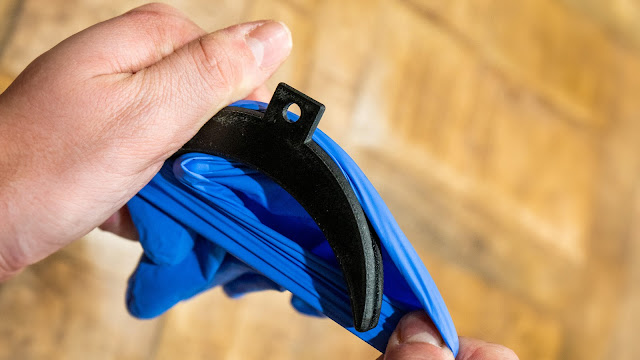USU Medical Students Invent Rapid Glove Applicator for Emergency Care
January 9, 2023 by Ian Neligh
Two fourth-year medical school students from the Uniformed Services University (USU) have patented a new device that can assist healthcare providers in quickly donning multiple glove layers — something essential during a potential mass casualty event when hygiene and timing are both critical.
Smith says the initial idea came about when he was approached by a special operations medic who needed a device that would help him to put on multiple layers of gloves at the same time for multiple casualty and mass casualty situations.
“He told me that, in these cases, he often wears several layers of gloves so that he can take off one layer of gloves at a time when moving rapidly from one patient to the next while maintaining body substance isolation,” says Smith.
The students’ invention keeps several layers of nitrile gloves suspended open, so someone can insert their hand and don multiple layers in a few seconds.
According to Bayne, during a mass casualty, or similar event, combat medics often omit using disposable gloves as it takes critical time away from treating patients.
“We wanted to address this issue by developing a device for medics to quickly put on multiple layers of gloves simultaneously,” says Bayne. “… Much of the current standard is (just) a wad of gloves shoved into your pocket just prior to receiving patients.”
Smith added the glove-layering device went through a host of iterations before the final pocket-sized version was established.
“From then, it was a matter of using computer-aided design software to draw up different ideas for a device that could meet this need, creating the designs with 3D printing, and testing each design until arrival at the final, functional product,” says Smith.
The two medical students say their device was assessed for patentability and then the University’s Technology Transfer Office assisted with securing a provisional patent.
“We have entered into the ‘licensing’ phase of production, in which we are identifying potential companies to license the Multilayer Glove Loader patent for mass production to get our product into the hands of our combat medics and corpsmen to provide better care for our warfighters,” says Bayne.
Smith says in addition to assisting in the patent process, the university helped offer time trial testing for the device, the 3D printing capabilities of the Medical Innovations Interest Group (MI2G) at USU.
“Without the USU Patent and Technology Transfer Office and the U.S. Army Medical Development and Research Command, our goal of being patent-pending inventors would not be the reality it is today,” says Smith.




